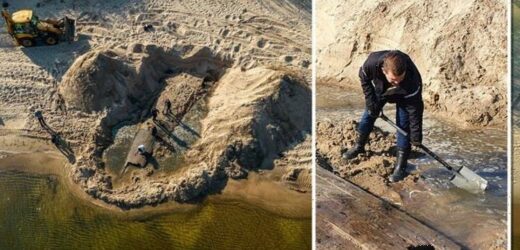Italy: Roman-era shipwreck discovered by Arpa
We use your sign-up to provide content in ways you’ve consented to and to improve our understanding of you. This may include adverts from us and 3rd parties based on our understanding. You can unsubscribe at any time. More info
Latvian authorities were alerted to the shipwreck’s discovery after local residents spotted a section of its hull poking out of the sand at Daugavgriva beach. Found just a few miles from the Latvian capital, the ship is believed to have been hidden away under a thick blanket of sand for 200 years. Archaeological excavations have since removed a blanket of sand measuring 36ft by 10ft (11m by 3m), revealing the well-preserved oak timber beneath.
According to the Office of the Freeport of Riga, the exposed remains were much bigger than initially assumed.
The group posted on Facebook: “Everything went well, but the further we dug, the clearer it became – the find was significantly bigger than any of us could have predicted.”
Measuring some 39ft by 13ft, most of the vessel remains buried under the sand – possibly even a whole ship.
Consequently, Latvian experts have so far been unable to precisely date the shipwreck.


But the ship’s oak construction suggests it could be between 150 and 200-years-old.
Copper nails found along the ship’s hull could also shed some light on its identity, according to a spokesperson for the Latvian National Cultural Heritage Board.
Copper-plating practices were adopted by the British in the 1870s and 1880s, which suggests the shipwreck dates to the 19th century.
Another clue is found in the nearby Daugavgriva lighthouse, which was built in the mid-19th century.
The spokesperson said: “It has likely sailed not only through the Baltic and North Seas but also on further voyages to the tropics.
Iceland: Expert discusses the 1944 SS Godafoss shipwreck
“Copper plating of underwater parts of ships was started by the British in the late 18th century, so this wreck probably dates back to the 19th century.”
The vessel would most likely been a warship or a long-distance merchant ship.
With only a section of the hull sticking out of the sand, Latvia’s archaeologists will investigate whether the whole structure can be excavated.
However, further digs risk damaging the timber wreck.


Janis Meinert, an archaeologist with the National Heritage Authority, said: “Finding such a large fragment of a shipwreck on the coast is a rare event and preserving it for future generations and exhibiting it is a difficult task.”
The worst thing to do at this stage, the expert added, is to rush the excavation without the proper resources in place.
For the time being, the archaeologists will preserve the exposed timber from the elements.
They did so by covering it with sand again so that it returns to the “humidity and environment where it has been perfectly preserved for 150 years”.
With the presently available data, the experts have also created a 3D model of the exposed hull that can be viewed online.
Copper-plating was pioneered by the Royal Navy in the 19th century as a means of preserving ship hulls from deterioration.
Hulls are affected by a whole range of marine creatures, such as barnacles, shipworms and weeds.
When copper comes into contact with water, it creates a poisonous film that keeps the marine organisms from latching onto the vessel.
Source: Read Full Article


